Without a hat to call attention to a woman’s head, 1960s hairstyles became a new focus for women in the Space Age. The bouffant look teased hair to new heights — literally. The flip, popular with teens, added the youthful girly look to the salon offerings. Short ’20s inspired bobs with guiche curls kissed her cheeks for another doll-like look. Hair length rose from shoulder to chin to cropped above the ears as the decade progressed, only to come crashing down again in the ’70s. In all, 1960s hairstyles took a wild ride ending with the natural look to kick off the 1970s.
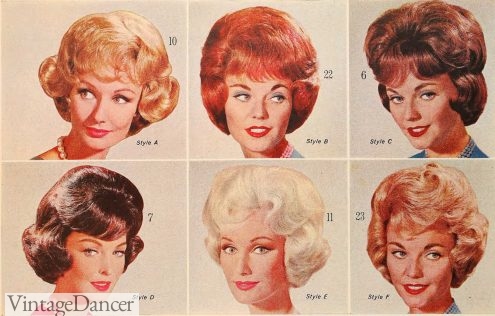
1964 Wigs in Curly Styles
These women’s 60s hairstyle photos will walk you through the key hairstyles of the 1960s and their names. A few 60s hairstyling tips at the end will give you ideas on how to create 60s hairstyles with minimal effort.
For men’s 1960s hairstyles, look here.
Gallery of 60s Hairstyles
Curly Italian
The Italian cut was a carry over from the 1950s, now with shorter sides, a high crown, and swooping bangs to cover the forehead. Oval, round, or shapes anywhere in between were exaggerated in any direction that made the wearer beautiful. Each style had volume, from a little to a lot, with more being better. Most hair length was at the jawline or above.
These styles were achieved with hot rollers, comb-outs, and a ton of hair spray. Many women went to weekly salon appointments to get the styling done or used foam curlers and a home bonnet hair dryer for in-between appointments.
- 1960 Georgia Carr’s Soft Curls
- 1960, Short Bangs, Slight Flip Behind the Ears
- 1963 Wigs
- 1967 Straight Bangs and Front Piece, Flipped Curls at the Back
- 1967 All Over Curls
- 1967 All Over Brushed Curls with a High Crown
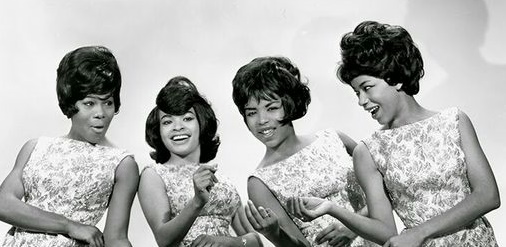
1961 Shaggy All Over Curls on the Marvelletes
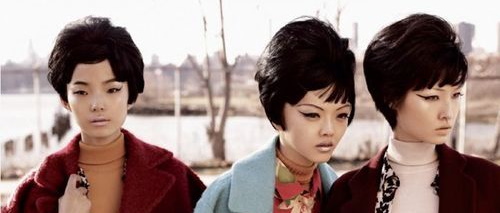
Early 1960s, Chinese Models with Bouffant Hairstyles
Straight Bob Hairstyles
For women not blessed with curl-able hair or who preferred a more youthful new look, there were short bobs and pixie cuts. Straight hair was cut to ear or chin length with long sweeping bangs pushed to one side. Short even bangs (fringe) and chin length chair were equally trendy in the later years.
Very short pixie cuts were still popular in the early 50s, but most women grew them out into the 60s bob. It helped that all things 1920s were being revived in fashion and hairstyling.
- Nancy Berg with Short Straight Bobbed Hair and Side Swoop Bangs
- Annette Brandler with a Short Pixie Cut
- Straight bob with Kiss Curls
- 1965 Straight Chin-Length Hair with Swoop Bangs
- 1966 Chin Length Bowl with bow Headband and Bangs
- 1969 Short Bobs, Very ’20s
Bouffant Hairstyles
‘Bouffant’ simply means a style of hair brushed into a puffy rounded shape. Bouffant could be small, medium, or giant size (the beehive), with the largest puff on the top of the head. Almost every other style of 60s hair incorporated a bouffant at some point. See how many you can find on this page!
To achieve the bouffant, women used a technique called ratting or back-combing. Hair was held up with one hand and a fine comb was rubbed up and down the hair strands to get them to knot like a rat’s nest. After ratting, the top layer was smoothed and shaped and held together by hairspray — a lot of hairspray. 1960s hairstyles were not kind to the hair or the environment.
One early 60s bouffant look incorporated hair bows on the center crown or slightly off center. Headbands, too, were easy hair accessories.
- 1963 Early Bouffant
- Marvelettes with Big Bows in Bouffant Hair
- 1961 Blonde Bouffant
- 1963 Red Bouffant Wig with Flip
- Bouffant Wigs
- 1967 Semi-Bouffant
Beehive Hair
The largest 1960s bouffant hairstyle became the beehive. It was cone shaped or “beehive” shaped from the ear to a foot above the crown. It took talent to create a beehive every morning, so few women did them at home. Extra hair padding and rats were used to gain the height, plus even more hairspray.
If I owned stocks in the 1960s, I would have invested in hair spray.
- Susan Auspach – Bouffant or Beehive?
- 1969 Beehive Hair for a Teen
- Tall Beehive
The Flip
Volume in 1960s hairstyles was achieved in non hair destroying fashion, too. The “flip” started with slightly teased hair on top, smooth straight sides, and curled tips that were curled outwards, creating a “flip” edge. Flips were chin length or longer until the end of the decade, when the flip was combined with the bob and the curls were turned back inward at ear level.
Simple headbands made the flip hairstyle especially charming for young girls, teens, and youthful ladies.
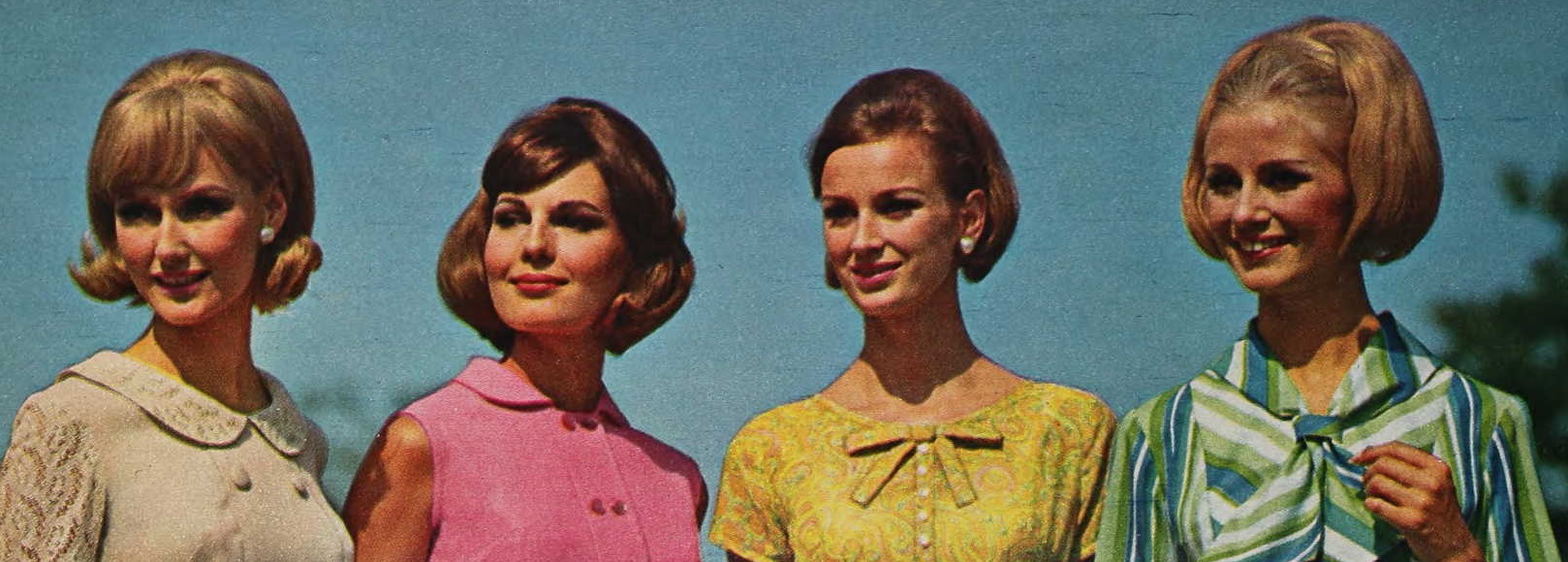
Flip Out, Flip In, and Two Bobs
- Diane Bradshaw, Sixties Flip with Headband
- 1962 Short Flip with Headband
- 1964 Flip with Tall Crown
- 1963 Flips, Flat Crown
- Medium-Length Flip, Bouffant Style
- 1969 Curled Flip bob
- Flip Curl Tips
- 1969 Inward Flip Bob with Hair Half-Back
Updos and Hair Pieces
With most women choosing short hairstyles in the 1960s, it’s odd that evening looks favored long hair. What was a short haired woman to do? Enter: hair switches and faux hair pieces. Long human hair pieces were sold in matching natural colors. They were then pinned to a straight and smooth updo. The switch was then wrapped into loose flat buns, rolls, loops, ringlet curls, figure eights, and other creative arrangements.
Full hair wigs were also very popular for thin haired or lazy women (that would be me). They came pre-styled in all sorts of trendy arrangements, and in all colors and textures.
- Susan Browning Updo with Loose Large Flat Bun
- 1965 Updo with Hair Tuck
- 1963 Hair Swatches Create Updos
- 1963 Hair Buns with Pieces
- 1967 Short Pixie with a Curly Hair Piece
- 1965 Updo with Bangs
- 1966 Figure 8 Rolls Updo with Bangs
- Wispy Bangs with Long Hair Gathered Back and Low
- 1964 Updo with Switches
- 1968 Updo
Long and Straight
By 1968-69, some young women were entering into a natural state of low-fuss, no-mess, long and straight hairstyles. The age of the hippies was the greatest influence, pushed further forward by fashionable stars like Cher. The half up, half down style was great for day or evening looks, giving women some variety to an otherwise simple 60s hairstyle. Long hair was also shaped into the flip and the bouffant top.
- Long Flip with Bangs
- 1969 Long Straight Hair with Ribbon Side Ponytails
- 1968 Half Up Down with Ringlet Curls
- 1969 Ring Curls, Half Up Down
- Cher with Long Hair and Bangs
- 1969 Long Straight Red Hair with Bangs
- Bouffant Up, Long Down with Curled Ends
- My Bouffant with Long Hair
Afro
The natural hairstyle trend was felt the most by African American women (and men) who had been straightening their hair for over a century. The free and curly Afro in the late 1960s was short and round, but growing bigger as the 1970s rolled in.
- Short Afro
- 1969 Afro Wig and Curly Wigs
How to Tease 60s Hair
(Submitted by a reader who lived through the 60s!)
You set your hair with tons & tons of hard-to-hold gel (today’s spiking gel) onto large rollers so that when your hair is dry, it’s so stiff it cracks. (Air drying is best).
Don’t brush the stiffness out or through, just separate the stiff strands as little as you can to manipulate them. Then, you don’t “tease” (that’s too mild) but you “rat” it with a ratting comb (a comb with close teeth of varying lengths) from end to root (stressing the root!), showing no mercy, until it it’s so matted it sticks out straight from your head and can’t/doesn’t move. Make sure there’s no gaps in the rat!
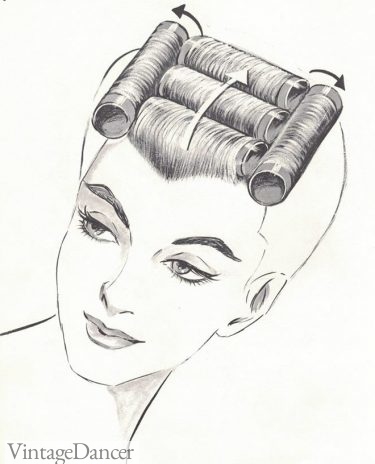
1963 rolling hair to the back and sides
Then with a small styling tool of your choice (toothbrush, small wire pick, etc.), you very carefully style just the ends of your hair over the ratted mound. The finishing touch is tons and tons of serious hairspray (freeze spray would be the modern version) — not all at once, but layer upon layer, allowing each layer to dry thoroughly, until it’s hard as a rock.
Also lift sections very very gently with a pick or rat tail to make sure the hairspray gets into the rat. Also, you have to make sure your hair is layered somewhat, because if the upper layers are too long they will collapse.
When finished, avoid humidity at all costs and wrap your hair up in toilet paper to preserve the style when you sleep. If you don’t succeed at first, try again. There’s no such thing as it “doesn’t work,” that term means you haven’t ratted hard enough or used enough product. 🙂 99% of 60s high school girls can’t be wrong! Tee hee.
Hair Tools I use
I have long hair and I hate teasing/back combing. Besides buying a full short hair wig, I have re-created a few long hair and updo styles that I use when I dress up 60s. The tools I use are:
Bump It – I bobby pin the large Bump-it to my crown and brush some long front hair pieces over it and around to the back for an almost half up/half down look. Bump Its can work for any medium to long length hair. The original Bump It I have is a hard plastic crescent shape crown. Newer Bump Its had a hair sponge on one side which would be more comfortable, but may not have the volume. You can add extra sponge rolls to get more height.
Hair Spray – Once the Bumpit is in place, I use Aussie Strong Hold Shine hairspray to freeze the style in place. I like Aussie because it brushes out very easily and doesn’t leave a sticky residue.
- My Bouffant with Long Hair
- My 60s Mad Men Inspired French Twist with Bouffant Top Updo
If I am doing an updo, I fix the bouffant first, then do a double French twist (became I have thick hair, a single twist will not hold), pin in place with a hundred bobby pins, spray, and call it a day. Its actually an easy style I can do in 30 minutes or less, and it looks great. I learned about French Twists in Lauren Rennell’s Vintage Hairstyling book from 2009 (there is an updated 2020 version I don’t have yet).
Other Useful Tools
Hot curlers or a curling iron to do most of the other 60s short hairstyles, “flipping” the ends, adding ringlets, etc
Hair switches / hair pieces – Either a 10-16 inch long hair switch you can arrange yourself or a pre-styled hair bun / bun curls/ ringlet bun you can slip into place. Avoid “messy buns” and choose instead smooth straight hair pieces.
Rat Comb – if you plan to tease your hair, you’ll need a fine tooth rat tail comb like these.
Add hair accessories such as a head band, big bow, ribbon ties, scarf, or pillbox hat.
Read More
- 1950s Women’s Hairstyles
- Bobs and Hairstyles of Women in the 1920s
- What Did Women Wear in the 1960s?
- 1960s Mad Men Clothing Styles
- ’60s Fashion for Hippies – Women and Men
Browse 1960s Wigs, Hairpieces, and Accessories:
Debbie Sessions has been teaching fashion history and helping people dress for vintage themed events since 2009. She has turned a hobby into VintageDancer.com with hundreds of well researched articles and hand picked links to vintage inspired clothing online. She aims to make dressing accurately (or not) an affordable option for all. Oh, and she dances too.
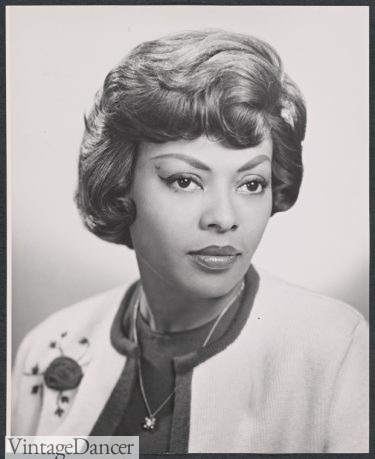
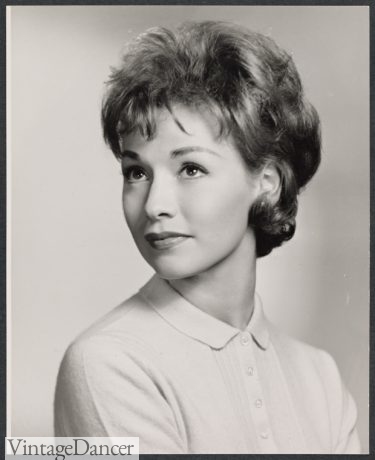
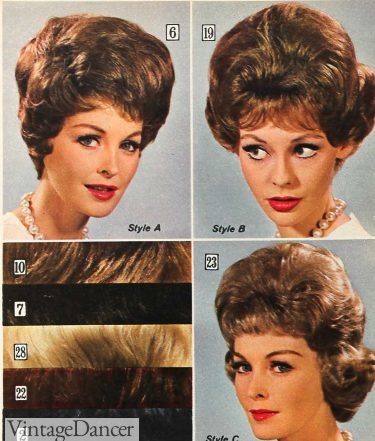
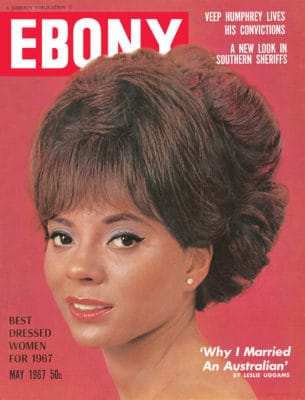
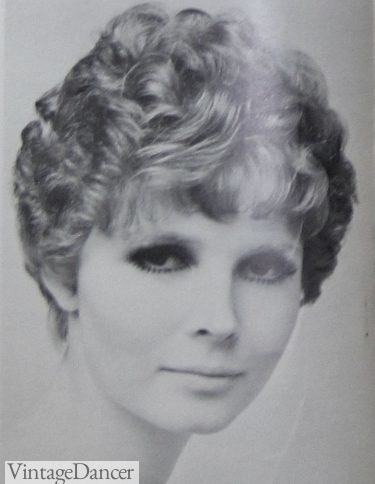
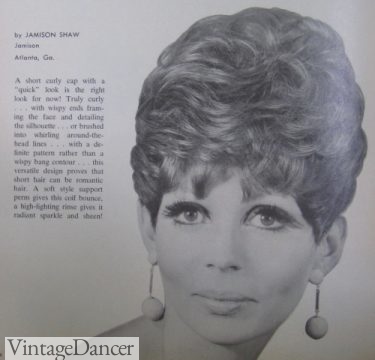
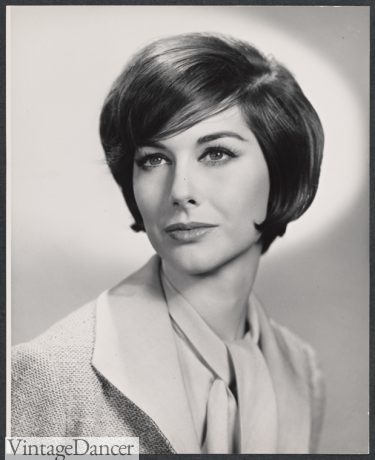
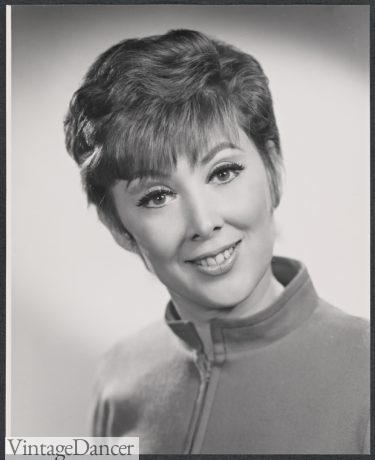
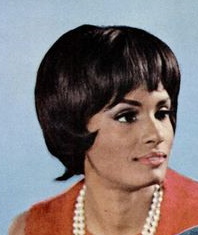
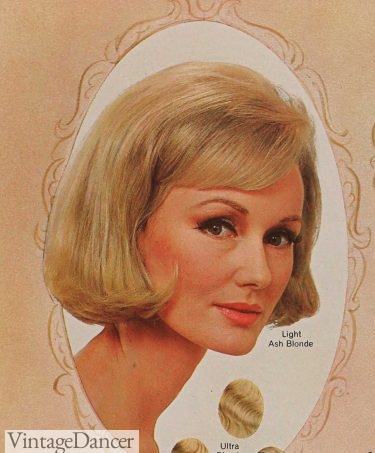
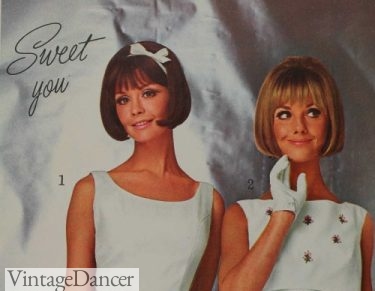
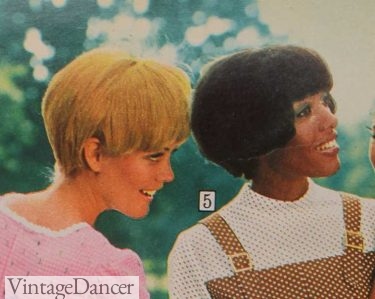
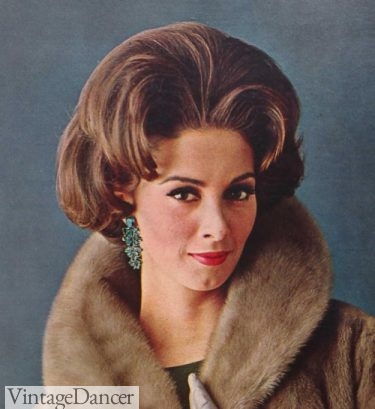
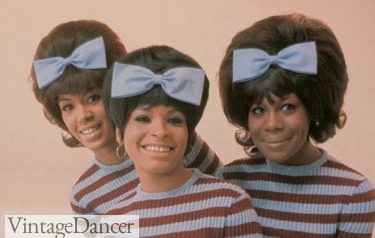
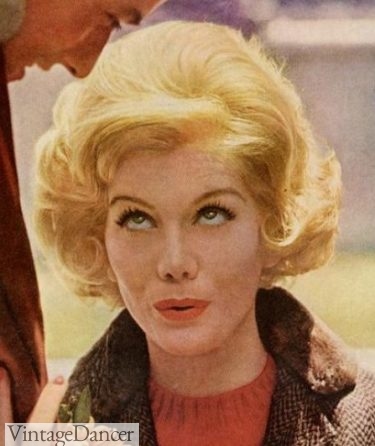
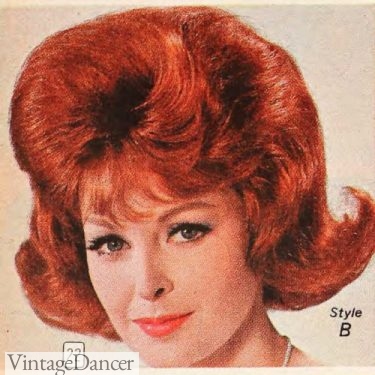
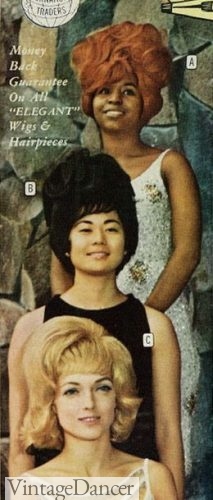
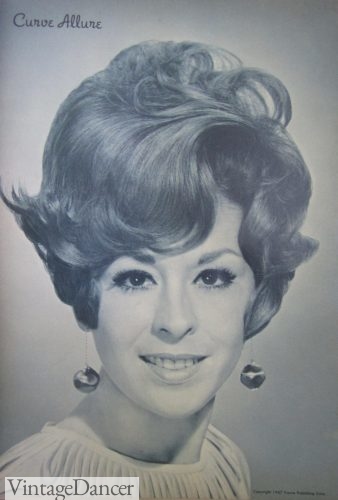
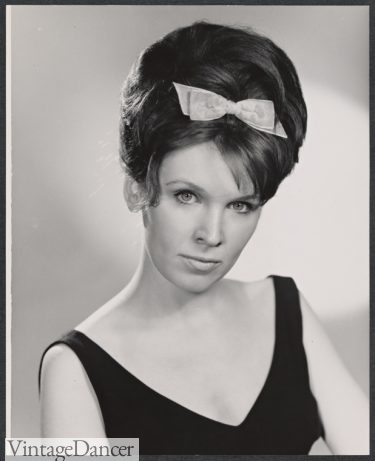
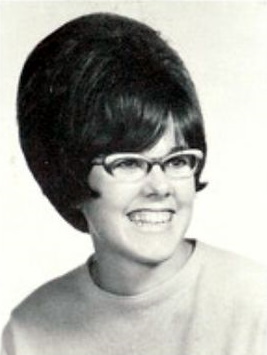
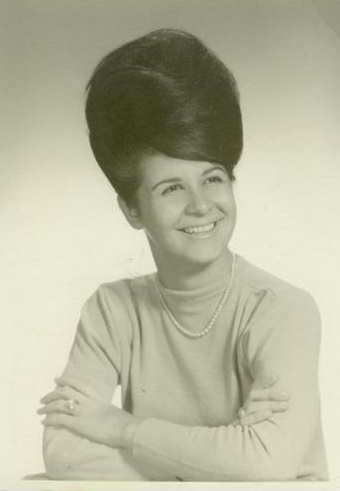

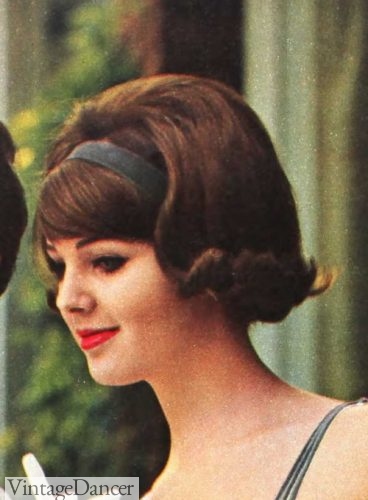
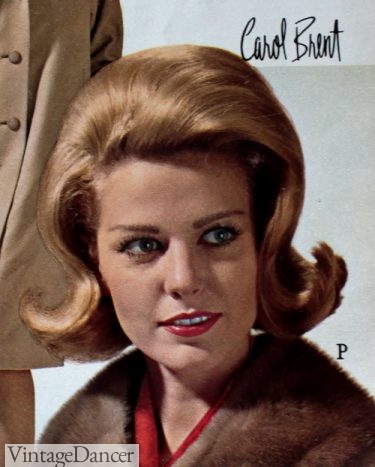
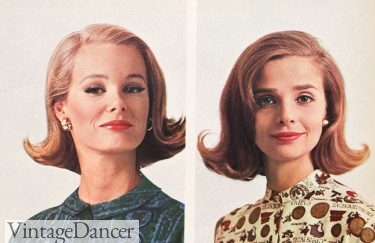
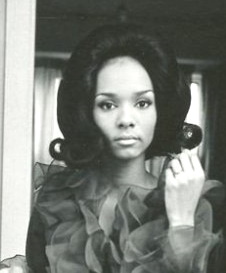
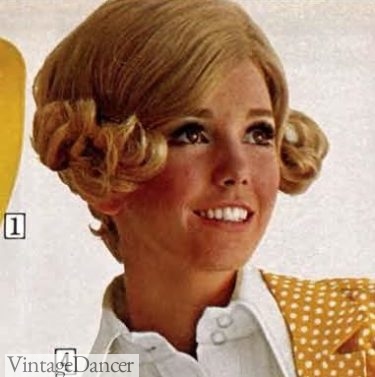
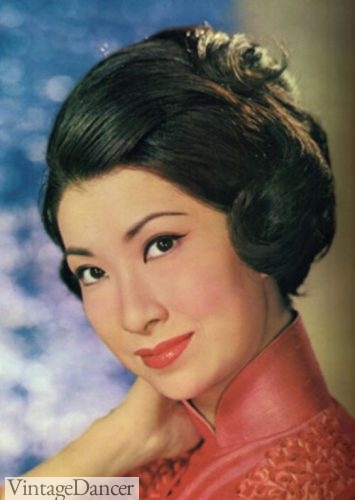
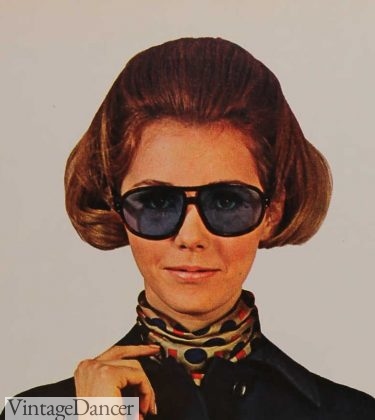
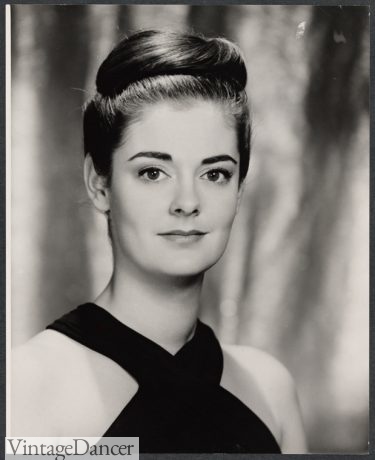
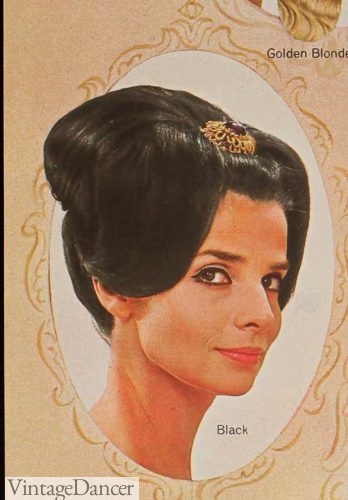
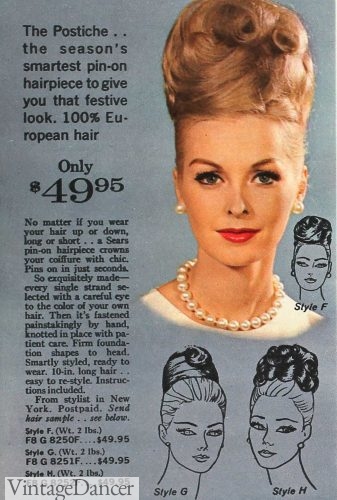
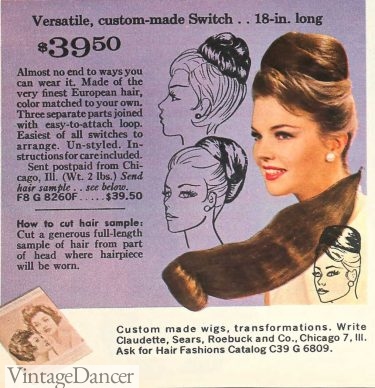
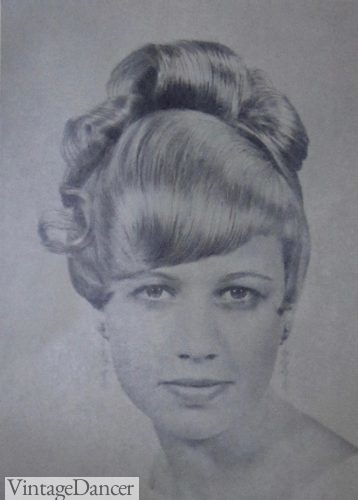
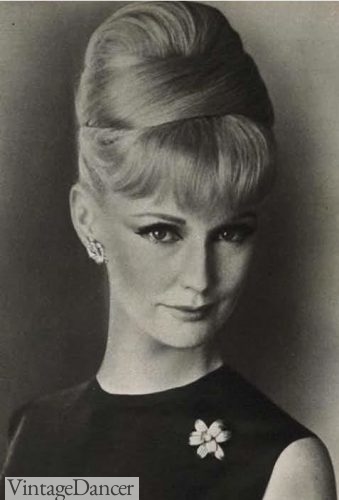
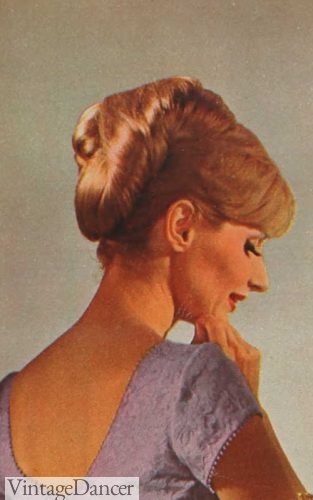
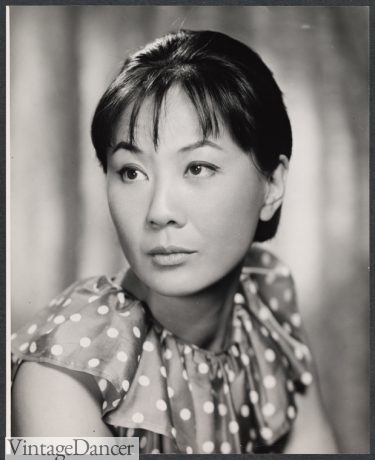
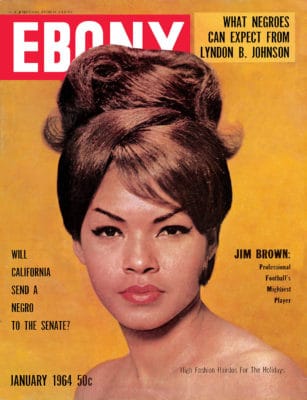
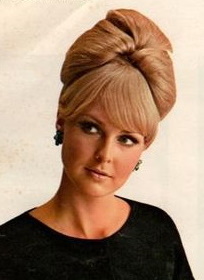
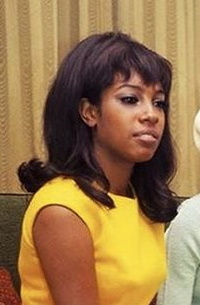
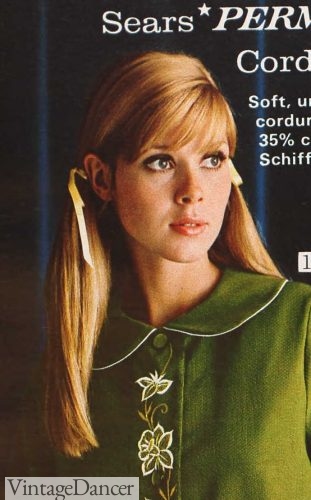
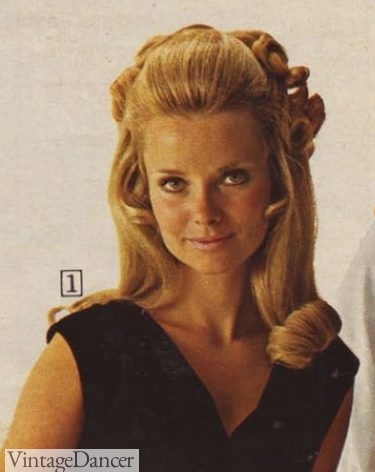
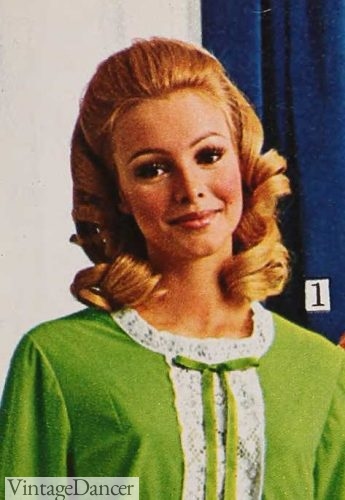
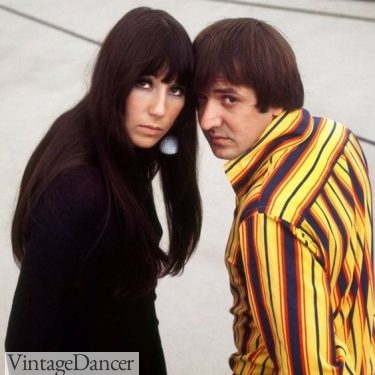
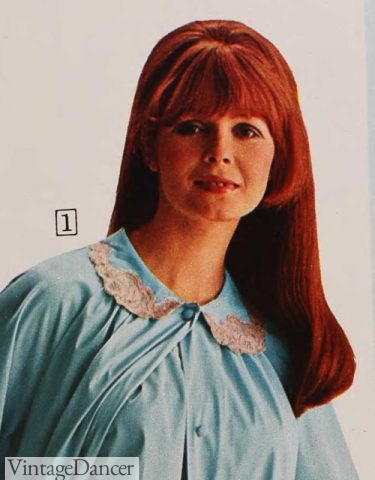
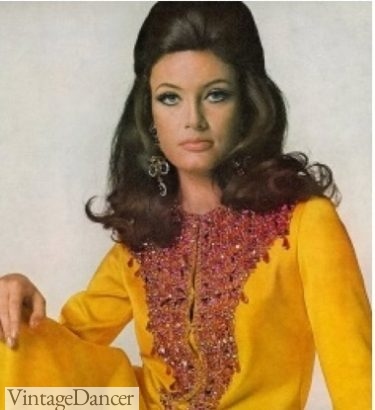
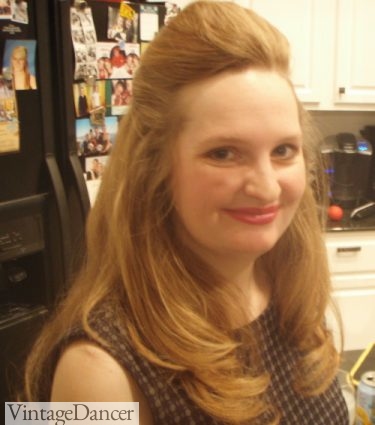
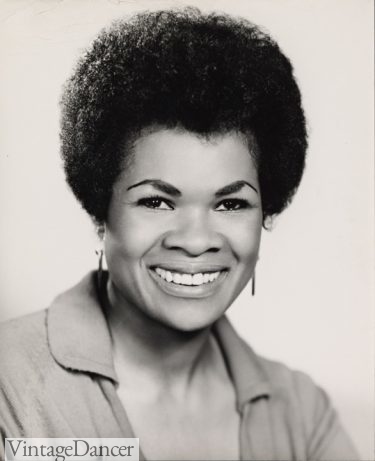
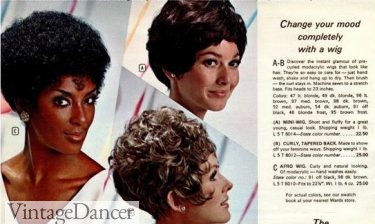
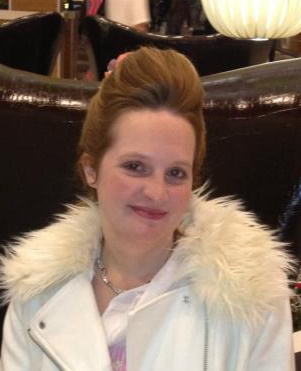
















![60s Hairstyles for Women and Teens 9 Inch Lace Front Strawberry Blonde Short Retro Style Bob Wig with Off-Center Lace Part and Curled Ends [Jazzy-24M/27] AT vintagedancer.com](https://i.etsystatic.com/10697761/r/il/07b954/5247724834/il_794xN.5247724834_5aap.jpg)
![60s Hairstyles for Women and Teens Light Blonde Short Curly Fluffy Bob Wig with Bangs [Sheela-613] AT vintagedancer.com](https://i.etsystatic.com/10697761/r/il/8c30d0/4902891357/il_794xN.4902891357_euzv.jpg)










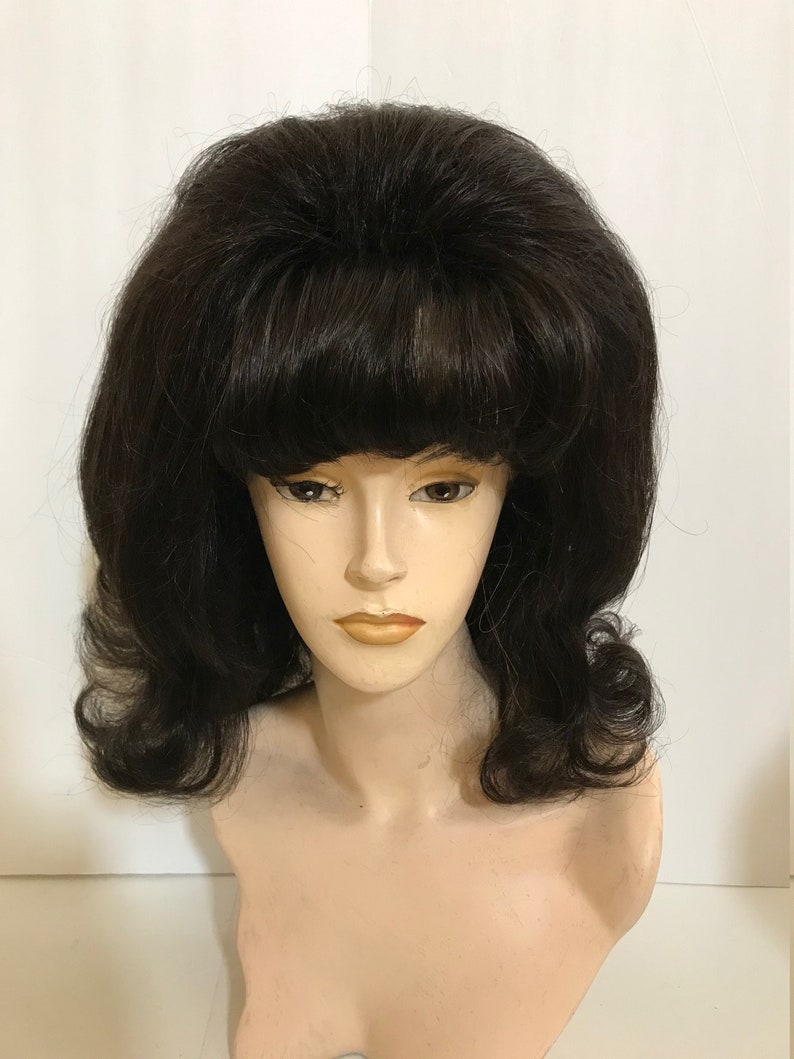

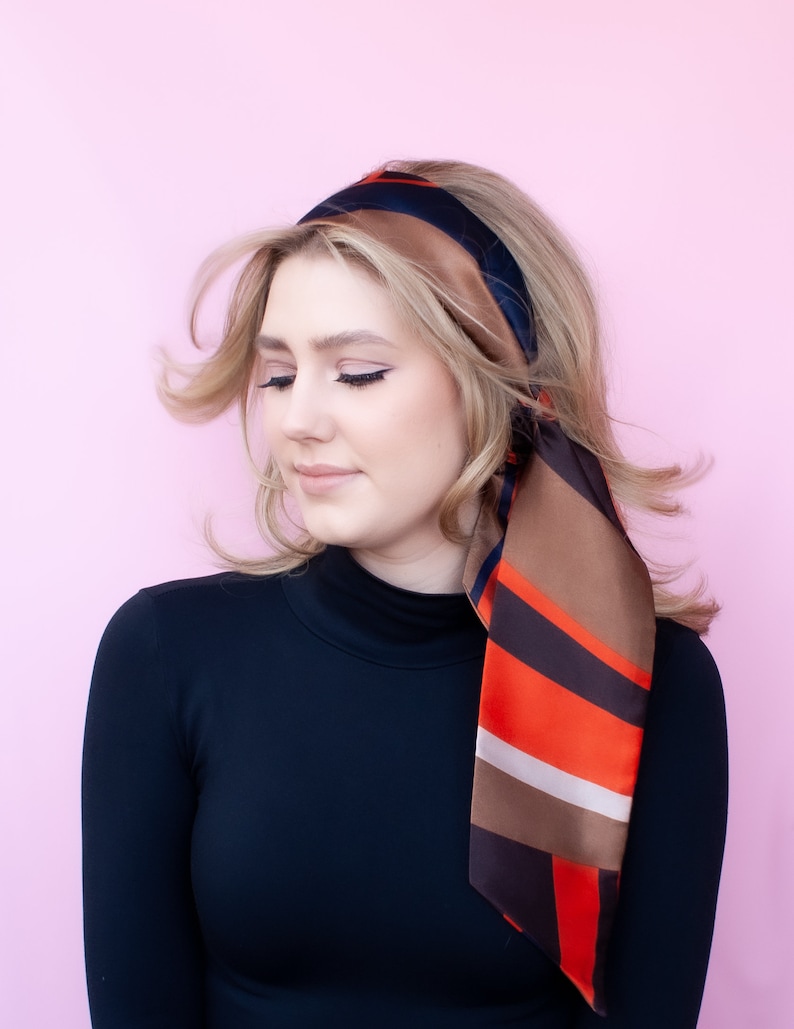
![60s Hairstyles for Women and Teens Long 17 inch Straight Blonde Beehive Costume Wig. [20-128-StBeehive-613] $49.99 AT vintagedancer.com](https://i.etsystatic.com/10697761/r/il/5f7e61/842646915/il_794xN.842646915_5vpj.jpg)